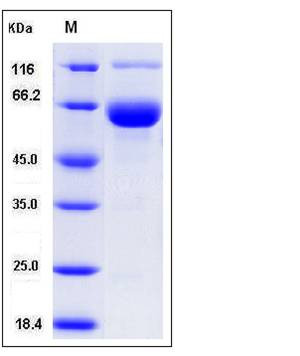Mouse CD33 / Siglec-3 Protein (Fc Tag)
gp67,Siglec-3
- 100ug (NPP3226) Please inquiry
| Catalog Number | P50712-M02H |
|---|---|
| Organism Species | Mouse |
| Host | Human Cells |
| Synonyms | gp67,Siglec-3 |
| Molecular Weight | The secreted recombinant mouse CD33/Fc is a disulfide-linked homodimer. The reduced monomer comprises 465 amino acids and has a calculated molecular mass of 51.6 kDa. As a result of glycosylation, the apparent molecular mass of rm CD33/Fc monomer is approximately 55-60 kDa in SDS-PAGE under reducing conditions. |
| predicted N | Gln 17 |
| SDS-PAGE |  |
| Purity | > 90 % as determined by SDS-PAGE |
| Protein Construction | A DNA sequence encoding the extracellular domain of mouse CD33 (Q63994-1) (Met 1-Glu 240) was fused with the Fc region of human IgG1 at the C-terminus. |
| Bio-activity | |
| Research Area | Signaling |Signal Transduction |ITIM/ITAM Immunoreceptors and Related Molecules |
| Formulation | Lyophilized from sterile PBS, pH 7.4 1. Normally 5 % - 8 % trehalose, mannitol and 0.01% Tween80 are added as protectants before lyophilization. Specific concentrations are included in the hardcopy of COA. |
| Background | Myeloid cell surface antigen CD33 also known as Sialic acid binding Ig-like lectin 3, CD33 antigen or Siglec-3, is a member of the immunoglobulin superfamily and SIGLEC (sialic acid binding Ig-like lectin) family. This Single-pass type I membrane protein contains 1 Ig-like C2-type (immunoglobulin-like) domain and 1 Ig-like V-type (immunoglobulin-like) domain. CD33 /Siglec-3 is a putative adhesion molecule of myelomonocytic-derived cells that mediates sialic-acid dependent binding to cells. CD33 /Siglec-3 preferentially binds to alpha-2,6-linked sialic acid. The sialic acid recognition site may be masked by cis interactions with sialic acids on the same cell surface. In the immune response, may act as an inhibitory receptor upon ligand induced tyrosine phosphorylation by recruiting cytoplasmic phosphatase(s) via their SH2 domain(s) that block signal transduction through dephosphorylation of signaling molecules. CD33/Siglec-3 induces apoptosis in acute myeloid leukemia (in vitro). CD33/Siglec-3 can function as a sialic acid-dependent cell adhesion molecule and that binding can be modulated by endogenous sialoglycoconjugates when CD33 is expressed in a plasma membrane. |
| Reference |
